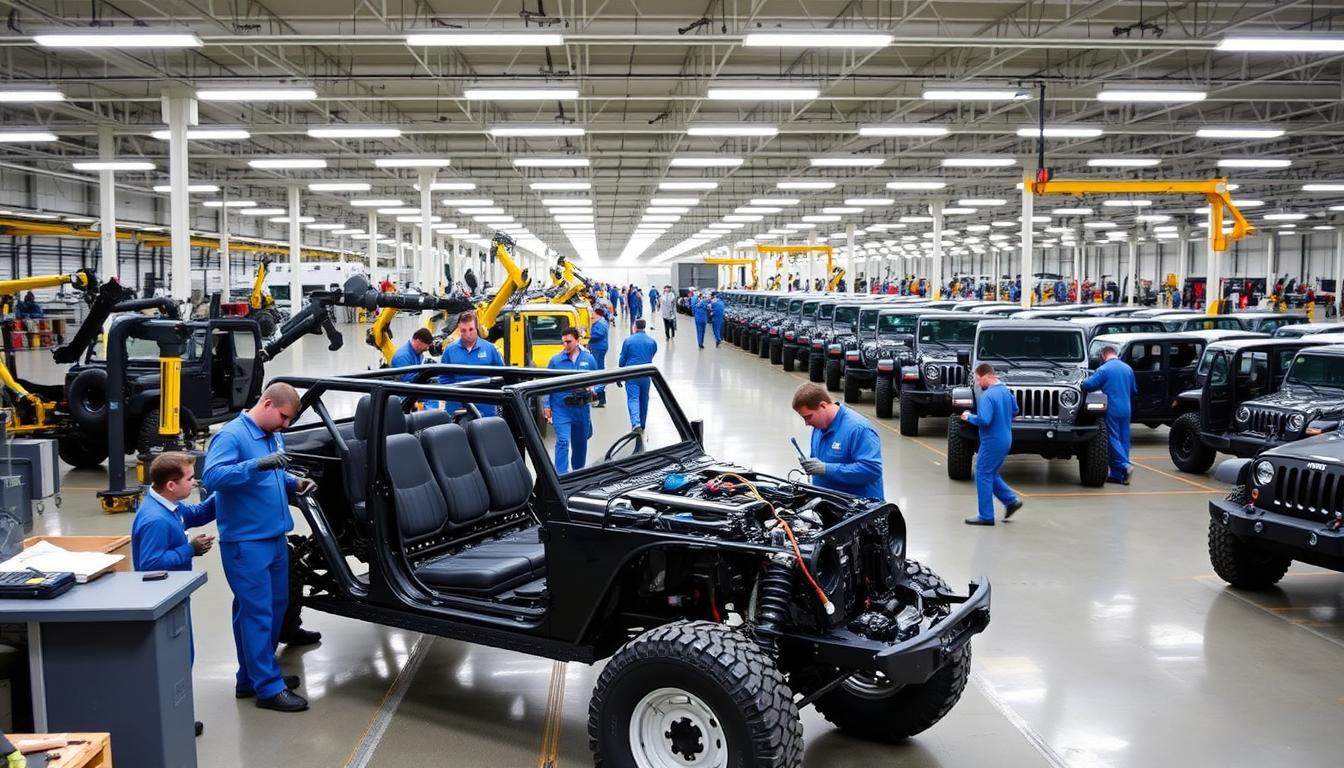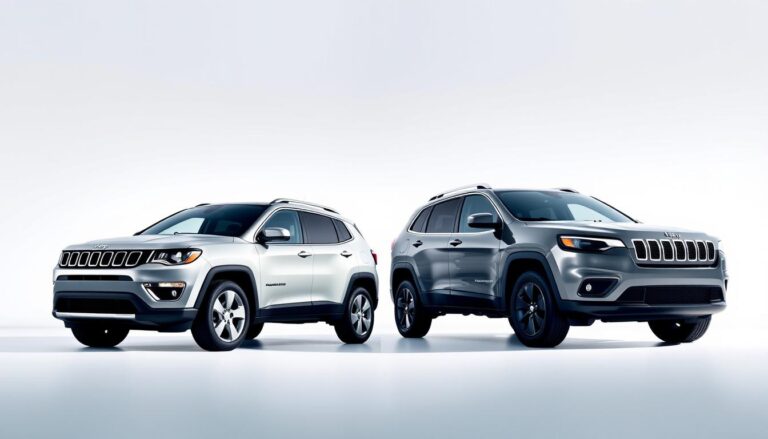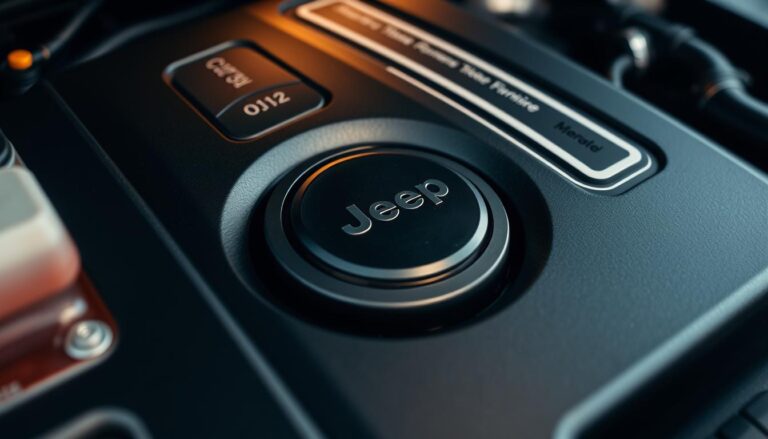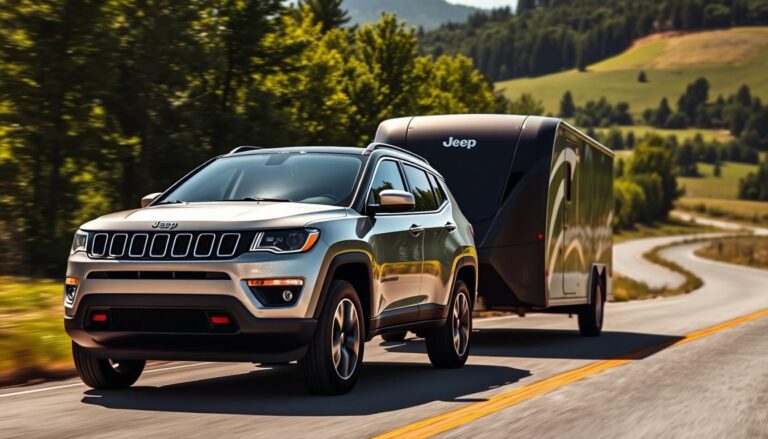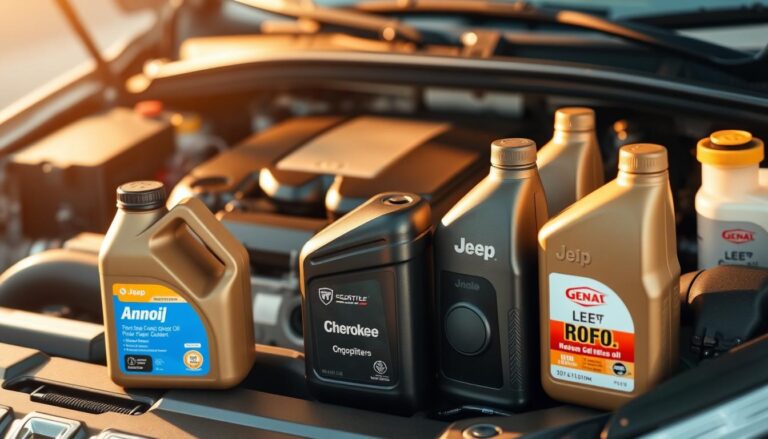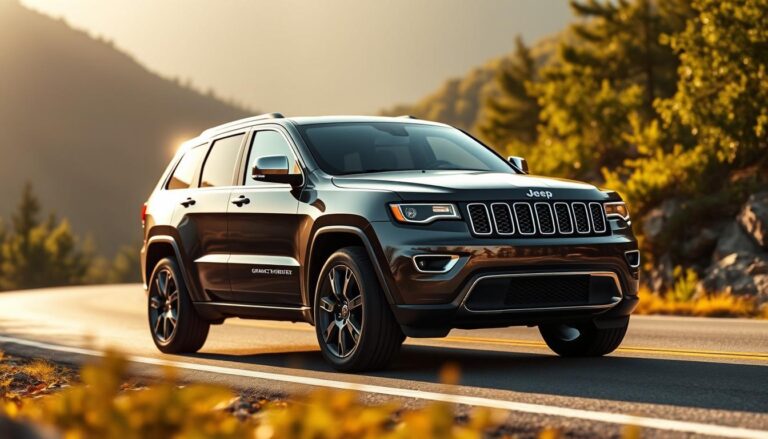The Jeep Manufacturing Process: Uncovering Where Jeeps Are Produced
Jeep is known for its tough design and advanced features. It’s a top name in the car world. The making of a Jeep starts with basic materials and ends with a strong car ready for any challenge.
The Jeep production is a mix of new tech and solid engineering. This part will give you a quick look at how a Jeep is made. It will show the detailed steps and how Jeep impacts the world.
Learning about Jeep’s start and how it makes cars shows its dedication to quality and new ideas. We’ll see the care and effort put into each Jeep. From its early days to now, Jeep’s making process shows its lasting legacy.
The History of Jeep Manufacturing
The story of Jeep manufacturing is both interesting and inspiring. It started in the tough times of World War II and has grown into a modern marvel. The Jeep is known for its toughness and smart design. Let’s explore the important moments that have shaped Jeep’s history and its wide reach.
Wartime Genesis
During World War II, the US military needed a vehicle that could handle tough terrains. The first Jeep, made by Willys-Overland, became famous for its strength and dependability. This time set the stage for Jeep’s focus on durability and performance.
The Jeeps from this era played a big role in the war. They proved their worth in the toughest conditions.
Post-war Evolution
After the war, Jeep became a favorite among civilians. The brand grew, and its production changed to meet civilian needs. Willys-Overland, later known as Kaiser Motors, updated its ways to meet more demand.
Jeep also started selling cars worldwide. This helped it become known globally.
Modern Era
In recent times, Jeep has kept pushing the limits of innovation. The brand has added new technologies and expanded its range of cars. The 1987 Chrysler buyout and later alliances with Fiat Chrysler Automobiles helped Jeep grow even more.
Today, Jeep’s factories are top-notch. They use the latest tech and skilled workers to make cars that are both tough and modern.
Where is a Jeep Made
Jeep’s manufacturing footprint spans multiple countries, each chosen for strategic reasons. Knowing where a Jeep is made shows the brand’s dedication to quality and accessibility. Jeep assembly plants are found worldwide, based on market demand, logistics, and production efficiency.
In the United States, the rich automotive history and skilled workforce make it ideal for Jeep production. The Toledo Assembly Complex in Ohio has been key for Jeep production from the start. Other important facilities are in China, India, and several European locations, helping Jeep reach a global audience.
Jeep’s choice of manufacturing sites is also influenced by regional market demands. For example, Asia’s growing SUV market leads to extensive manufacturing in China and India. In Europe, strategic sites meet specific model demands, ensuring timely distribution and market penetration.
The commitment to quality and innovation in Jeep’s manufacturing is evident. Jeep’s global presence means that consumers worldwide get vehicles that meet Jeep’s high standards. Exploring where a Jeep is made sheds light on this strategic logistical planning, designed for a diverse and dynamic global market.
| Country | Primary Manufacturing Locations |
|---|---|
| United States | Toledo, Ohio; Detroit, Michigan; Belvidere, Illinois |
| China | Guangzhou, Changsha |
| India | Ranjangaon |
| Italy | Melfi |
| Brazil | Goiana |
Primary Jeep Manufacturing Locations
Jeep has set up its plants in different countries to meet global needs and improve production. We’ll look at key jeep manufacturing locations across the globe.
United States
The United States is at the heart of Jeep’s manufacturing, with Toledo, Ohio, being a major site. Jeep’s history in the U.S. shows its commitment to quality and innovation. This makes it a favorite among Americans.
The Toledo Assembly Complex is famous for making the Jeep Wrangler. It shows Jeep’s strong manufacturing skills and support for the American workforce.
China
In China, Jeep has set up plants to serve the huge local market. By placing factories in key areas, Jeep meets the demand for SUVs in China. This strategy also helps make vehicles more affordable and tailored for the Chinese market.
India
India is also a key market for Jeep, with its own jeep factory locations. The focus is on making models like the Jeep Compass for Indian tastes. This approach strengthens Jeep’s position in a competitive market and supports local business and consumer needs.
Jeep’s global plan uses each location’s strengths while keeping the brand’s quality high. From the U.S. to China and India, each factory is essential in getting Jeeps to customers worldwide.
Jeep Production Facilities in the United States
The United States is home to several important Jeep assembly plants. These plants are key in making various Jeep models. The Toledo Assembly Complex, the Baltimore Operation, and the Belvidere Assembly Plant are among them. Each plant has its own role in Jeep’s production network, from making specific models to employing a large workforce. Let’s explore each plant’s details.
Toledo Assembly Complex
The Toledo Assembly Complex in Ohio is a historic and vital part of Jeep’s production. It has been key to Jeep’s production for decades, starting in World War II. This facility mainly makes the Jeep Wrangler and the Jeep Gladiator. It has thousands of workers, showing its huge production scale.
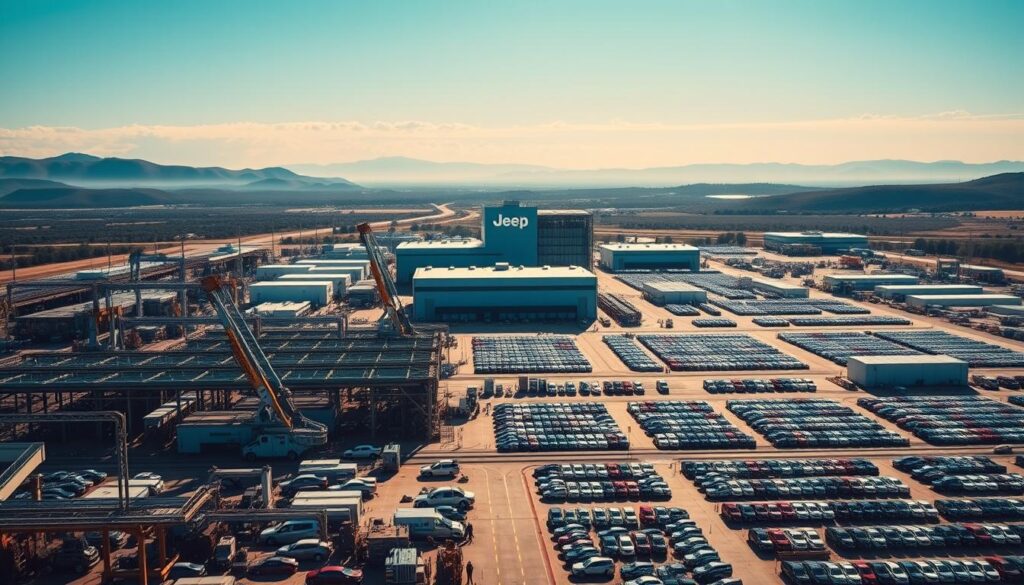
The Toledo Assembly complex has two main units: Toledo North and Toledo South. The North plant focuses on the Wrangler and its different trims. The South plant makes the Gladiator. This setup helps in efficient production and specialized assembly lines.
Baltimore Operation
In Maryland, the Baltimore Operation is a major Jeep assembly plant. It’s known for making the Jeep Cherokee, meeting the growing demand in the American market. Its location and advanced technology make it a strong part of Jeep’s production.
The Baltimore plant also makes parts for other Jeep models. This helps in improving efficiency and reducing production time.
Belvidere Assembly Plant
The Belvidere Assembly Plant in Illinois is key for the Jeep Compass and Jeep Renegade. It’s known for its advanced manufacturing and a dedicated workforce. As a major jeep assembly plant, Belvidere is important for meeting both regional and international demands.
| Plant | Location | Main Models | Workforce |
|---|---|---|---|
| Toledo Assembly Complex | Ohio | Wrangler, Gladiator | Thousands |
| Baltimore Operation | Maryland | Cherokee | Thousands |
| Belvidere Assembly Plant | Illinois | Compass, Renegade | Thousands |
Jeep Production Countries Around the Globe
Jeep is known worldwide and makes cars in many countries. The United States is a big base, but Jeep also makes cars in other places. Each country adds something special to Jeep’s range of cars.
In South America, Brazil is key with its Goiana plant. It makes the Jeep Compass and Renegade for the local market. This shows Jeep’s ability to make cars that fit local tastes and rules.
In Europe, Jeep makes cars in Italy, mainly at the Melfi Assembly Plant. They make the Renegade and Compass for European buyers. This plant shows how important it is for Jeep to make cars that meet European standards.
Jeep also works with GAC Group in China. The GAC Fiat Chrysler plant in Guangzhou makes the Cherokee and Compass. This shows Jeep’s effort to make cars that Chinese buyers want.
Here’s a quick look at where Jeep makes cars and what they make. It shows Jeep’s wide reach and smart planning:
| Country | Main Models Produced | Key Plants |
|---|---|---|
| Brazil | Compass, Renegade | Goiana Plant |
| Italy | Renegade, Compass | Melfi Assembly Plant |
| China | Cherokee, Compass | GAC Fiat Chrysler, Guangzhou |
| India | Compass | Ranjangaon Plant |
| United States | Wrangler, Gladiator | Toledo Assembly Complex |
Jeep’s global network helps it make cars that fit different markets. This wide reach helps Jeep meet the needs of buyers all over the world. It shows Jeep’s skill in making cars that are both good and varied.
The Role of Technology in Jeep Manufacturing
Technology has changed the jeep manufacturing process a lot. It has brought in new ways to automate, use robots, and check quality. These changes help make sure every Jeep is reliable and performs well.
Automation
Automation has made the jeep manufacturing process smoother. Machines handle tasks from getting materials to putting parts together. This makes the process faster and more accurate, cutting down on mistakes.
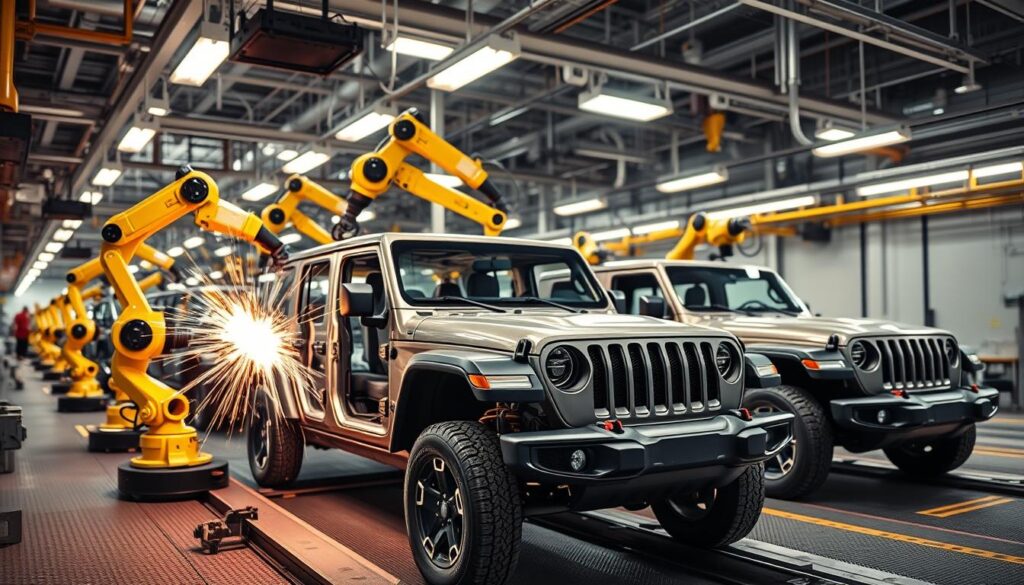
Robotics
Robots are key in making Jeeps better. They do jobs like welding and painting with great care. This means Jeep vehicles stay high in quality. Robots also make the workplace safer by reducing the need for human labor.
Quality Control
Quality control is very important in making Jeeps. The latest tech is used to find and fix any problems early on. Cameras and sensors check each part carefully. This makes sure every Jeep meets Jeep’s high standards.
Environmental Factors in Jeep Manufacturing
Jeep is working hard to reduce its impact on the environment. They focus on sustainability and cutting down waste. Their goal is to be a leader in eco-friendly car making.
Sustainability Initiatives
Jeep’s main plan is to lower emissions and make cars more fuel-efficient. They also use renewable energy in their factories. This shows their dedication to green technology and alternative energy.
Waste Reduction
Jeep is also focused on managing waste better. They use advanced recycling and support a circular economy. This helps a lot in reducing waste and landfill use.
Here are some ways Jeep reduces waste:
- Material Recyclability: Using materials that can be recycled in car making.
- Process Optimization: Making manufacturing steps more efficient to reduce waste.
- Supplier Collaboration: Working with suppliers to adopt sustainable practices.
These efforts make Jeep’s manufacturing process both strong and green. It shows their commitment to being sustainable and innovative in the car industry.
The Supply Chain Behind Jeep Manufacturing
The jeep supply chain is complex and key to Jeep’s success. It connects global suppliers, uses advanced logistics, and optimizes operations. This forms a strong supply chain.
Jeep works with a global network of suppliers. This ensures each Jeep gets top-quality parts from around the world. The network is vital for getting raw materials, electronics, and special parts for Jeep’s advanced models.
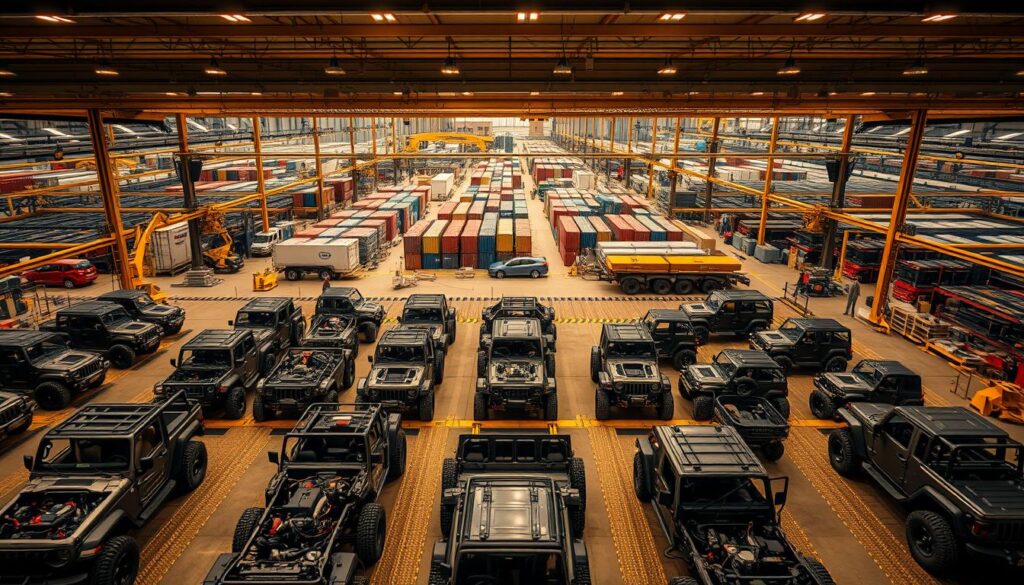
Logistics are critical in the jeep supply chain. Good logistics systems help parts get to plants on time. This cuts down on downtime and boosts production. Systems track inventory and manage supplier coordination accurately.
Jeep also focuses on sustainability in its supply chain. It aims to cut carbon emissions in transport and chooses eco-friendly suppliers. This shows Jeep’s dedication to the environment.
The jeep supply chain balances supply management and technology. It shows how careful planning and execution make each vehicle reliable and of high quality.
Jeep Assembly Plants: A Global Overview
Jeep assembly plants are found on several continents. This shows the brand’s dedication to quality vehicles worldwide. Each plant focuses on different models and uses new technologies for consistency and durability.
In the United States, the Toledo Assembly Complex is a key site. It produces popular models like the Jeep Wrangler and Gladiator. This facility is known for its advanced operations and large production capacity. Other countries also play a big role in Jeep’s global production, helping the brand meet market needs.
| Country | Notable Plant | Main Models Produced |
|---|---|---|
| United States | Toledo Assembly Complex | Wrangler, Gladiator |
| China | Guangzhou Plant | Compass, Cherokee |
| India | Ranjangaon Plant | Compass |
| Mexico | Saltillo South Plant | Jeep Compass |
The connection between these jeep assembly plants helps Jeep meet the needs of its customers everywhere. Each plant adds something special to the production process. This network makes the brand strong and quick to respond to market changes.
Challenges in the Jeep Manufacturing Process
The jeep manufacturing process has many challenges. It needs to be adaptable and resilient. Issues like labor problems, supply chain issues, and the need for new technology are common.
Labor Issues
Labor disputes affect jeep manufacturing a lot. Strikes, negotiations, and changes in labor laws are ongoing. Companies must find a balance between fair labor and keeping production on track.
Supply Chain Disruptions
Supply chain problems are a big challenge. Delays in getting raw materials, shipping issues, and global politics can stop production. The COVID-19 pandemic showed how vulnerable supply chains are and the need for backup plans.
Technological Upgrades
Keeping up with technology is essential in jeep manufacturing. New tech like automation and robotics can improve the process but cost a lot. It’s a challenge to stay current with technology without breaking the bank.
Future of Jeep Manufacturing
Jeep is on the verge of a big change with electric and self-driving cars. They’re leading the way in making cars that are good for the planet and packed with new tech. This change will make driving better than ever before.
Electric Vehicles
Jeep is going green with electric cars. They’ve already launched the Jeep Wrangler 4xe and the electric Jeep Recon. These cars use strong batteries and are built for adventure, making them both eco-friendly and tough.
Autonomous Driving
Jeep is also diving into self-driving cars. This move will change how we drive on and off the road. With smart sensors and AI, Jeep’s self-driving tech will make driving safer, more efficient, and fun.
Conclusion
The journey through Jeep’s manufacturing process shows a rich history. It started in wartime and has grown to today’s advancements. The jeep’s origin and factory locations show that making cars is a global effort.
Jeep is made in the United States, China, and India. The Toledo Assembly Complex is a key example of Jeep’s focus on quality. They use advanced tech like automation and robotics to make sure Jeeps are top-notch.
Despite challenges like labor issues and supply chain problems, Jeep looks to the future. They’re working on electric vehicles and self-driving cars. This shows their commitment to leading in the car industry.

